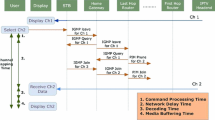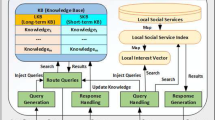Abstract
This paper proposes a novel adaptive cellular automaton co-occurrence (CACO) approach to forming information societies in smart cities. It develops an interest ontology of cellular automaton (CA) clustering using a zone of community in an urban environment. The key to the proposed method is to integrate CA clustering with the ontology of user interests. We also adopt an interest ontology and a co-occurrence mechanism to calculate the relation between time and the popularity of the information. In addition, we take advantage of the pheromone mechanism to determine if the data transferred to the destination are popular and to analyze if there exists any duplication. The simulation results reveal the strengths of the proposed “adaptive CACO mechanism” model in terms of decreased delay rate, next hop probability, and service time.


















Similar content being viewed by others
References
Conti, M., Giordano, S., May, M., & Passarella, A. (2010). From opportunistic networks to opportunistic computing. IEEE Communications Magazine, 48(9), 126–139.
Pelusi, L., Passarella, A., & Conti, M. (2006). Opportunistic networking: data forwarding in disconnected mobile ad hoc networks. IEEE Communications Magazine, 44(11), 134–141.
Haitao, L., Baoxian, Z., Mouftah, H., Xiaojun, S., & Jian, M. (2009). Opportunistic routing for wireless ad hoc and sensor networks: Present and future directions. IEEE Communications Magazine, 47(12), 103–109.
Conti, M., Delmastro, F., & Passarella, A. (2009). Social-aware content sharing in opportunistic networks. 6th Annual IEEE communications society conference on sensor, mesh and ad hoc communications and networks workshops, pp. 1–3.
Karamshuk, D., Boldrini, C., Conti, M., & Passarella, A. (2011). Human mobility models for opportunistic networks. IEEE Communications Magazine, 49(12), 157–165.
Perkins, C. E. (2001). Ad Hoc networking. New Jersey: Addison-Wesley.
Fall, K. (2003). A delay-tolerant network architecture for challenged internets. Proceedings of the ACM SIGCOMM’03.
Musolesi, M., & Mascolo, C. (2009). CAR: Context-aware adaptive routing for delay-tolerant mobile networks. IEEE Transactions on Mobile Computing, 8(2), 246–260.
Jain, S., Fall, K., & Patra, R. (2004). Routing in a delay tolerant network. Proceedings of the ACM SIGCOMM’04.
Zhao, V., Ammar, M., & Zegura, E. (2004). A message ferrying approach for data delivery in sparse mobile ad hoc networks. Proceedings of the ACM MobiHoc’04.
Sarafijanovic-Djukic, M. P. N., & Grossglauser, M. (2006). Island hopping: Efficient mobility assisted forwarding in partitioned networks. Proceedings of the 3rd annual IEEE conference sensor and ad hoc communications and networks (SECON’06).
Boldrini, C., Conti, M., & Passarella, A. (2008). Exploiting users’ social relations to forward data in opportunistic networks: The HiBOp solution. Pervasive and Mobile Computing, 4(5), 633–657.
Hui, P., Crowcroft, J., & Yoneki, E. (2011). BUBBLE rap: Social-based forwarding in delay tolerant networks. IEEE Transactions on Mobile Computing, 10(11), 1576–1589.
Ding, G., & Bhargava, B. (2004). Peer-to-peer file-sharing over mobile ad hoc networks. Proceedings of the IEEE PerComW’ 04, Orlando, FL, pp. 104–108.
Daly, E., & Haahr, M. (2007). Social network analysis for routing in disconnected delay-tolerant MANETs. In Proceedings of the ACM MobiHoc, pp. 32–40.
Hui, P., Crowcroft, J., & Yoneki, E. (2008). Bubble rap: Social-based forwarding in delay tolerant networks. In Proceedings of the ACM MobiHoc, pp. 241–250.
Motani, M., Srinivasan, V., & Nuggehalli, P. (2005). Peoplenet: Engineering a wireless virtual social network. In Proceedings of the ACM MobiCom, pp. 243–257.
Srinivasan, V., Motani, M., & Ooi, W. (2006). Analysis and implications of student contact patterns derived from campus schedules. In Proceedings of the ACM MobiCom, pp. 86–97.
Vahdat, A., & Becker, D. (2000). Epidemic routing for partially connected ad hoc networks. Duke University, Durham, NC, Technical Report CS-200006.
Watts, D., & Strogatz, S. (1998). Collective dynamics of small-world networks. Nature, 393, 440–442.
Lindgren, A., Doria, A., & Schelen, O. (2003). Probabilistic routing in intermittently connected networks. Computing and Communications Review, 7(3), 19–20.
Zhao, W., Ammar, M., & Zegura, E. (2004). A message ferrying approach for data delivery in sparse mobile ad hoc networks. In Proceedings of the ACM MobiHoc, pp. 187–198.
Gao, Wei., Li, Qinghua., Zhao, Bo., & Cao, Guohong. (2012). Social-aware multicast in disruption-tolerant networks. IEEE/ACM Transactions on Networking, 20(5), 1553–1566.
Fall, K. (2003). A delay-tolerant network architecture for challenged internets. In Proceedings of the ACM SIGCOMM, pp. 27–34.
Pentland, A., Fletcher, R., & Hasson, A. (2004). DakNet: Rethinking connectivity in developing nations. IEEE Computer, 37(1), 78–83.
Sushant, J., Fall, K., & Patra, R. (2004). Routing in a delay tolerant network. In Proceedings of the SIGCOMM’04.
Pasarella, A., Kumar, M., Conti, M., & Borgia, E. (2011). Minimum-delay service provisioning in opportunistic networks. IEEE Transactions on Parallel and Distributed Systems, 22(8), 1267–1275.
Boldrini, C., Conti, M., & Passarella, A. (2008). Exploiting users’ social relations to forward data in opportunistic networks: The HiBOp solution. Pervasive and Mobile Computing, 4(5), 633–657.
Spyropoulos, T., Psounis, K., & Raghavendra, C. (2008). Efficient routing in intermittently connected mobile networks: The multiple-copy case. IEEE Transactions Networking, 16(1), 63–76.
Chaintreau, A., Hui, P., Diot, C., Gass, R., & Scott, J. (2007). Impact of human mobility on opportunistic forwarding algorithms. IEEE Transactions on Mobile Computing, 6(6), 606–620.
Boldrini, C., Conti, M., & Passarella, A. (2009). Design and performance evaluation of content place, a social-aware data dissemination system for opportunistic networks. Computer Networks, 54(5), 589–604.
Missoum, S., Gürdal, Z., & Setoodeh, S. (2005). Study of a new local update scheme for cellular automata in structural design. Structural and Multidisciplinary Optimization, 29(2). doi:10.1007/s00158-004-0464-2
Chen, H., Finin, T., Joshi, A., Kagal, L., Perich, F., & Chakraborty, D. (2004). Intelligent agents meet the semantic web in smart spaces. IEEE Internet Computing, 8(6), 69–79.
Protégé Home Page. http://protege.stanford.edu/.
Silva, J., & Willett, R. (2009). Hypergraph-based anomaly detection of high-dimensional co-occurrences. IEEE Transactions on Pattern Analysis and Machine Intelligence, 31(3), 563–569.
Garcia, E. (2008). Targeting documents and terms: Using co-occurrence data, answer sets and probability theory. http://www.miislita.com/semantics/c-index-3.html.
Li, M., Dias, B., El-Deredy, W., & Lisboa, P. J. G. (2007). A probabilistic model for item-based recommender systems. In Proceedings of the ACM international conference on recommender systems.
Li, H., & Abe, N. (2002). Word clustering and disambiguation based on co-occurrence data. In Proceedings of the 19th international conference on computational linguistics.
Globerson, A., Chechik, G., Pereira, F., & Tishby, N. (2007). Euclidean embedding of co-occurrence data. Journal of Machine Learning Research, 8, 2265–2295.
Jhanwar, N., Chaudhuri, S., Seetharaman, G., & Zavidovique, B. (2004). Content based image retrieval using motif cooccurrence matrix. In Proceedings of the 4th Indian conference computer vision, graphics and image processing, Vol. 22, no. 14, pp. 1211–1220.
Hofmann, T., & Puzicha, J. (1998). Statistical models for co-occurrence data. Technical report AIM-1625, Massachusetts Institute of Technology, citeseer.ist.psu.edu/article/hofmann98statistical.html.
Rabbat, M. G., Figueiredo, M. A. T., & Nowak, R. D. (2008). Network inference from co-occurrences. IEEE Transactions on Information Theory, 54(9), 4053–4068.
Kubica, J., Moore, A., Cohn, D., & Schneider, J. (2003). cGraph: A fast graphbased method for link analysis and queries. In Proceedings of the IJCAI text-mining link-anal. workshop, Acapulco, Mexico, pp. 22–31.
Pham, H., Hu, L., & Shahabi, C. (2011). A geo-social model: From real-world co-occurrences to social connections. IN Proceedings of the 7th international conference on databases in networked information systems, pp. 203–222.
Maihöfer, C. (2004). A survey of geocast routing protocols. IEEE Communications Surveys & Tutorials, 6(2), 32–42.
Heissenbüttel, M., & Braun, T. (2003). Ants-based routing in large scale mobile ad-hoc networks, Kommunikation in Verteilten Systemen (KiVS).
Günes, M., Sorges, U., & Bouazizi, I. (2002). ARA—The ant-colony based routing algorithm for MANETs proceedings of the ICPP workshop on ad hoc networks (IWAHN 2002), IEEE Computer Society Press, pp. 79–85.
Günes, M., Kähmer, M., & Bouazizi, I. (2003). Ant routing algorithm (ARA) for mobile multi-hop ad-hoc networks—New features and results, the second mediterranean workshop on ad-hoc networks.
Roth, M., & Wicker, S. (2003). Termite: Ad-hoc networking with stigmergy. IEEE Global Telecommunications Conference, 5, 2937–2941.
Bonabeau, E., Dorigo, M., & Theraulaz, G. (1999). Swarm intelligence: From natural to artificial systems. Oxford: Oxford University Press.
Ross, S. (1996). Stochastic processes, 2nd Edn. New York: Wiley.
Kelly, F. P. (1979). Reversibility and stochastic networks. New York: Wiley.
Acknowledgments
We thank the National Science Council of Taiwan for funding this research (Project No.: NSC MOST 103-2221-E-218-037).
Author information
Authors and Affiliations
Corresponding author
Rights and permissions
About this article
Cite this article
Horng, GJ. Opportunistic Content Sharing Scheme for Distributed Network in City Environments. Wireless Pers Commun 84, 2327–2350 (2015). https://doi.org/10.1007/s11277-015-2707-5
Published:
Issue Date:
DOI: https://doi.org/10.1007/s11277-015-2707-5




